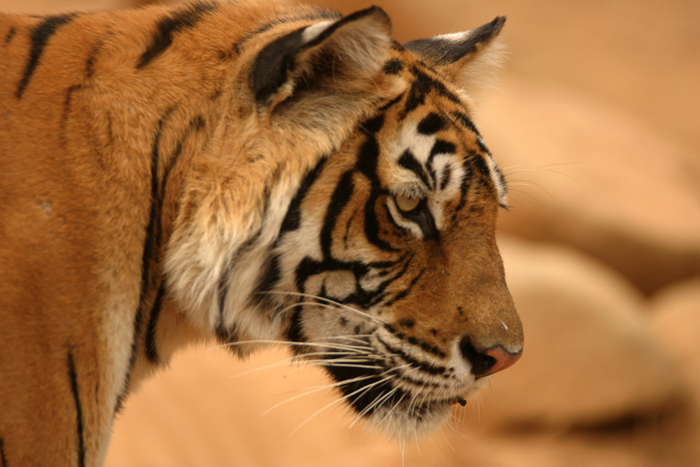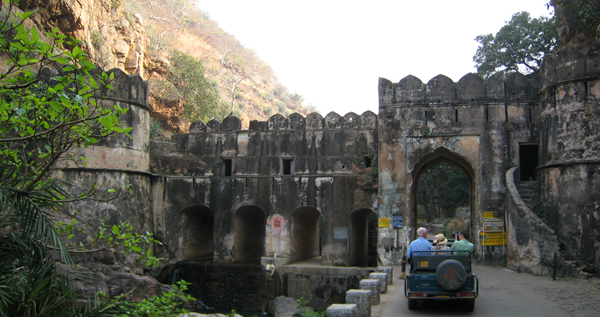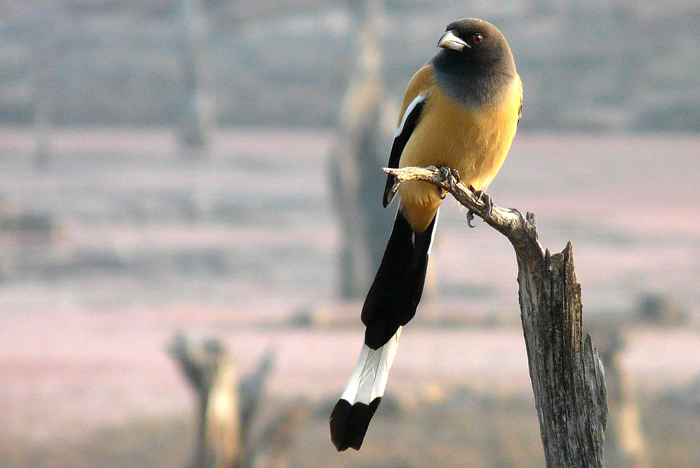 Ranthambhore National Park : Ranthambore National Park is probably the best place in the world to see wild tigers and is the only dry deciduous tiger habitat in the world. The Ranthambore National Park, which is a part of the much larger Ranthambore tiger reserve, a Project tiger reserve, lies in the Sawai Madhopur district of eastern Rajasthan. It is the only forest reserve in Rajasthan state and in the entire Aravali hill ranges where wild bengal tigers still exist. The dry deciduous habitat of the reserve makes it much easier to find and observe tigers in their natural wild habitat.
Ranthambhore National Park : Ranthambore National Park is probably the best place in the world to see wild tigers and is the only dry deciduous tiger habitat in the world. The Ranthambore National Park, which is a part of the much larger Ranthambore tiger reserve, a Project tiger reserve, lies in the Sawai Madhopur district of eastern Rajasthan. It is the only forest reserve in Rajasthan state and in the entire Aravali hill ranges where wild bengal tigers still exist. The dry deciduous habitat of the reserve makes it much easier to find and observe tigers in their natural wild habitat.
The Chambal River forms a natural boundary of the Ranthambore national park towards the east, and on the eastern shore of Chambal lies the central Indian state of Madhya Pradesh. To the northeast of the Ranthambore national park, flows the river - Banas, a tributary of Chambal. Across the river Banas, lies the Keladevi sanctuary, while the Sawai Man Singh wildlife sanctuary lies to the south of the Park. Both these sanctuaries, along with the Ranthambore national park, are part of the Ranthambore tiger reserve. Today, this Project tiger reserve spans over 1334 sq. km of area, of which 282 sq. km is the Ranthambore national park.
 The entire Tiger Reserve stretches in a North-East to South-West direction for a distance of over 70kilometers. To the extreme North-East lies the Kela Devi Sanctuary, south-west of which (and across the river Banas) lies theRanthambore National Park. The Sawai Madhopur Sanctuary, followed by the Sawai Mansingh Sanctuary and the Qualji Closed Area lies further South-West of the park.
The entire Tiger Reserve stretches in a North-East to South-West direction for a distance of over 70kilometers. To the extreme North-East lies the Kela Devi Sanctuary, south-west of which (and across the river Banas) lies theRanthambore National Park. The Sawai Madhopur Sanctuary, followed by the Sawai Mansingh Sanctuary and the Qualji Closed Area lies further South-West of the park.
Ranthambore is where the Aravali and the Vindhyan hill ranges meet and this confluence is perhaps the reason for the rich bio diversity of the Ranthambore. The geological formations of Vindhyan system are characterized by flat table tops locally known as 'Dang' , while the Aravallis are characterized by sharp ridges and conical hill tops. An important geological fault line - the Great Boundary Fault - lies at the confluence of the Aravali and the Vindhyan systems and runs right across Ranthambore national park.
All the Tiger safaris in the Reserve are conducted inside the National park.
The park is open to tourists during October-June, and receives more than 100,000 wildlife enthusiasts every year from all over the world.
 Ranthambhore Fort: The Ranthambhore fort is believed to have been built in 944 A.D. by a Chauhan ruler. It is strategically located on the border of Rajasthan and erstwhile Malwa The Undulating topography of the surrounding forests was used as an outerdefense to the advantage of the fort. It was one of the strongest forts of Northern India.
Ranthambhore Fort: The Ranthambhore fort is believed to have been built in 944 A.D. by a Chauhan ruler. It is strategically located on the border of Rajasthan and erstwhile Malwa The Undulating topography of the surrounding forests was used as an outerdefense to the advantage of the fort. It was one of the strongest forts of Northern India.
The fort had many buildings inside of which only a few have survived the ravages of wars and time. Among the remaining ruins, the two pavilions, Badal Mahal and Hammirs court and parts of the royal palace give an idea of the old grandeur. For water supply there are two rain fed reservoirs in the fort.
The fort also has an old temple devoted to lord Ganesh which attracts a lot of pilgrims and visitors.
Trinetra Ganesh Temple: Trinetra means three eyes; the temple was named by this reason. Legend about the Deity.Legend has it that Parvati created Ganesh out of the sandalwood dough that she used for her bath and breathed life into him. Letting him stand guard at the door she went to have her bath. When her husband, Shiva returned, the child who had never seen him stopped him. Shiva severed the head of the child and entered his house. Parvati, learning that her son was dead, was distraught and asked Shiva to revive him. Shiva cut off the head of an elephant and fixed it on the body of Ganesh.
Another tale tells of how one day the Gods decided to choose their leader and a race was to be held between the brothers- Kartikeya and Ganesh. Whoever took three rounds of the earth first would be made the Ganaadhipati or the leader. Kartikeya seated on a peacock as his vehicle, started off for the test. Ganesh was given a rat, which moved swiftly. Ganesh realised that the test was not easy, but he would not disobey his father. He reverently paid obeisance to his parents and went around them three times and thus completed the test before Kartikeya. He said, " my parents pervade the whole universe and going around them, is more than going round the earth." Everybody was pleasantly surprised to hear Ganesh's logic and intelligence and hence he came to be known as the Ganaadhipati or leader, now referred to as Ganpati.
Amreshvar Mahadev Temple: Revered ShivTemple, The waterfall and the Verdant grove make this spot ideal for picnics.
 Sawai Man Singh Sanctuary: "Sawai Man Singh Sanctuary" is situated 9 km away from Sawai Madhopur on Sawai Madhopur-Kalibhat road. It is a part of Sawai Mansingh sanctuary. The area includes the confluence of the ancient Aravalli hill, system with the Vindhyan hill system due to which the area is a very rich in bio-diversity. The Vindhyan system is characterized by flat table tops (plateaus) locally known as "Dang’ and Aravallis are characterized by sharp ridges & conical hill tops.
Sawai Man Singh Sanctuary: "Sawai Man Singh Sanctuary" is situated 9 km away from Sawai Madhopur on Sawai Madhopur-Kalibhat road. It is a part of Sawai Mansingh sanctuary. The area includes the confluence of the ancient Aravalli hill, system with the Vindhyan hill system due to which the area is a very rich in bio-diversity. The Vindhyan system is characterized by flat table tops (plateaus) locally known as "Dang’ and Aravallis are characterized by sharp ridges & conical hill tops.
The camping site is surrounded by bold vertical cliffs of Neemli 'Dang'. Eco trails and motorable paths have been developed to visit the 'Dang'. Know is another beautiful feature of the Dang. It is a very deep, wide and long rocky Nallah cutup in the Dang which is characterised by steep rocky slopes and cliffs, flat bottoms with deep and fertile soil Mahakho and Didikho are two khos which are very cool mist and alive throughout the year.
Flora : The main vegetation is dhok associated with beautiful trees of cheela, Raunj, Tendu, Gurjan, Kadaya, Khaair, Kadamb, Goya khair, Siras, Jamun, Khirni, Saintha, Salar, Kathphadi, Amaltas etc. Undergrowth is mostly jarked, jal, Gangerun, jhadberi . Ground cover is mostly grasses of species Chinkali, Bhanjura, Lampla, Sheen, Sedvs, Loth, Jhonudali, Dada Musi Pharda.
Fauna : The Main animals of the area are Chinkaras, Nilgai, Chital, Sambhar, Hare, Fox, Jackal, Hyena, Jingle Cat, Wild Boar, Sloth beer and Panther. Avifauna is represented by Peacock, Partridges, Quails, Sand grouse, Stone curlews, Minivets, Flycatchers, Tits, Orioles, Parakeets, Sparrow, and Vultures. Nesting of vultures can also be seen in the area.
Amali Deh: Situated amidst the landscape greenery against backdrop of river Banas & stroke of blue skyline beyond, attached to Kela Devi Sanctuary. 35 kms (45 minutes) drive through villages, river Banas is a bird watcher’s paradise, Rajasthani dinner with bonfire make the trip exclusive.
Surval Lake: Located 14km from Sawai Madhopur is a shallow seasonal lake, situated between acres of agricultural fields, which usually dries out by April/May is home to a large number of different kinds of migratory birds during the winter. Painted storks, flamingoes, spoonbills, sarus cranes, greylag geese amongst others can be seen in large numbers in between the months of November and March. During this season, the best time to see birds is very early in the morning and serious bird watchers should be at the lake before sunrise.
Mansarovar Lake: This water bodies on the age of the park attract thousand of migrating bird during winter and are specially exiting for bird watching some time in this area we can find some wild animals also, there is fisher men with the boats also we can hire those boats for boating in this lake.